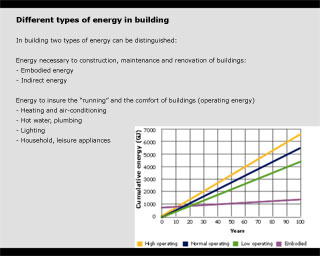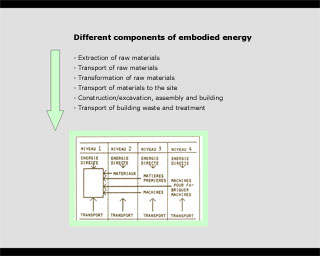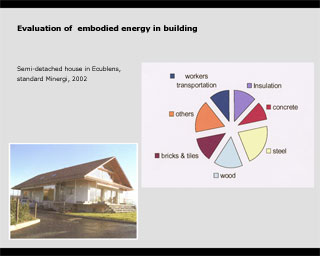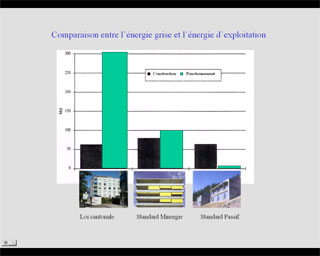Different types of energy
in building
Different types of energy in building
In building two types of energy can be distinguished:
• Energy necessary to the construction of the building and
its maintenance
• Energy running energy which ensures its operation during
its lifetime
At the moment of construction or renovation of
a building, a good conception of its envelope and technical installations
will allow for a reduction of energy of exploitation. In the same
way, consideration, for example, about choice of materials, construction
methods, sustainability of components and flexibility of spaces,
will allow for a reduction of energy in construction.
The graph below shows that energy necessary for
construction (embodied energy) is used from construction (year 0)
and increases slowly and gradually with maintenance work.
After 10-15 years of use, the operation energy
already overtakes that of construction. After 80 years (length of
life often applied in building for calculations), the operation
energy is three or four times superior to the energy used in construction.

Different types of energy in building
Different components of embodied
energy

Different components of embodied energy
Evaluation of embodied energy
in building

Evaluation of embodied energy in building
Comparison between embodied energy
and operation energy
The comparison, made over a period of 80 years,
between grey energy needs and energy needs for exploitation/operation
reduced to m2 of heated floor per year for various construction
standards shows us that:
• For the standard Minergie and especially
for the standard Passif, the proportion of embodied energy in the
overall estimate is large. Consideration is required as to choice
of materials for example, construction methods, sustainability of
components and flexibility of space.
• For new constructions respecting Cantonal
limits, energy for exploitation/operation of buildings over 80 years
is much greater, a factor of about 3 to 4.
It should be noted that:
• Buildings constructed before 1985 still
consume about 3 times more energy.
• Minergie or Passif buildings represent
less than 5% of new constructions.
• The amount of new constructions over a
year is below 2% of the total number of existing properties.

Comparison between grey energy and operation
energy
Construction energy and energy
operation energy
• For a traditional construction and throughout
the lifetime of a building (80 years) energy needs for its construction
and maintenance will not exceed 15-20% of the operation energy
• Between a light construction and a heavy
construction, non-renewable energy needed for its construction can
vary by a factor of 2.
|
![]()